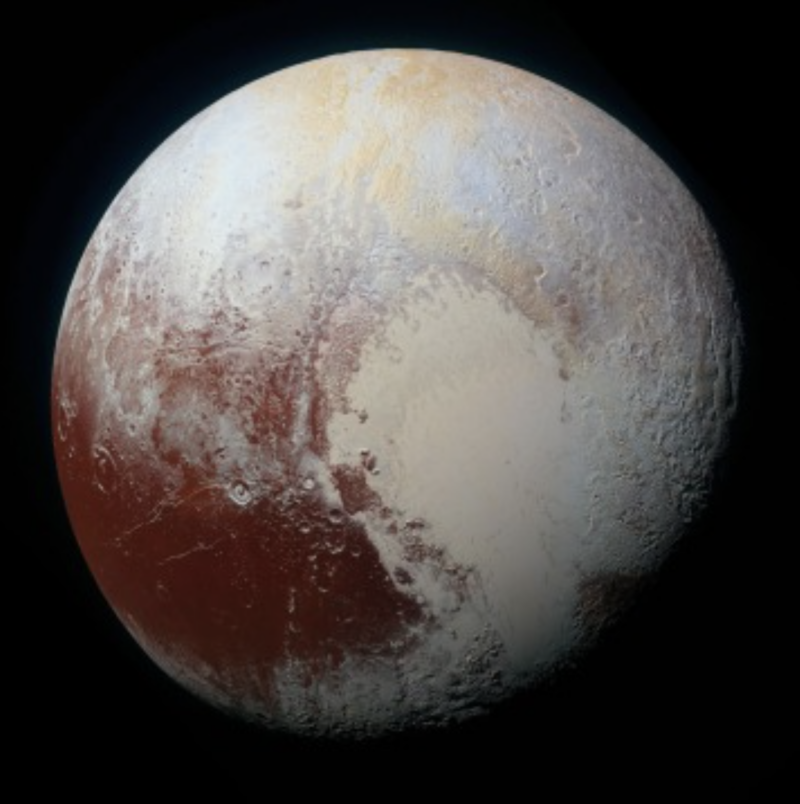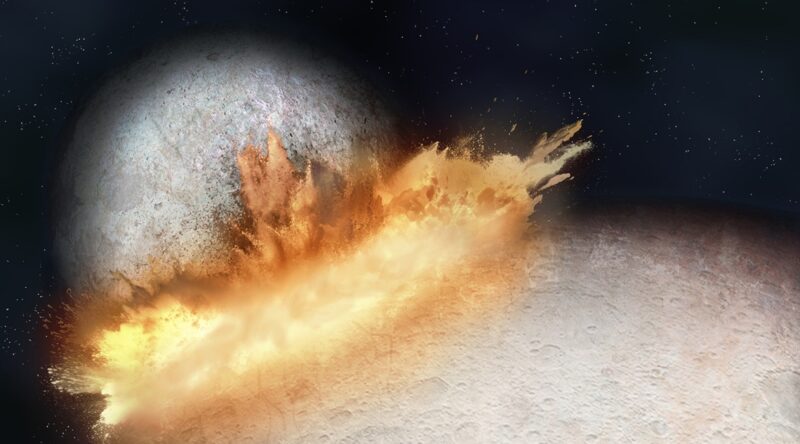EarthSky’s Deborah Byrd created this 1-minute video summary for you. How Pluto got its heart!
- New insights on the origin of Pluto’s heart-shaped feature came from scientists using numerical simulations.
- They said a cataclysmic collision created the western lobe of Pluto’s heart, called Sputnik Planitia. The impacting body was over 400 miles in diameter. It altered Pluto’s inner structure.
- These scientists now doubt Pluto has a subsurface ocean. Their simulations suggest the heart’s formation and position on Pluto can explained by a local mass excess from the impact, rather than ocean dynamics.

How Pluto got its heart
Scientists said yesterday they have new insights about how the dwarf planet Pluto got its giant heart-shaped feature. NASA’s New Horizons spacecraft first spied Pluto’s heart when it swept past the little world in 2015. Scientists named the heart-shaped feature Tombaugh Regio for Clyde Tombaugh, who discovered Pluto in 1930. But the heart on Pluto has puzzled scientists with its unique shape, geological composition and elevation. Now scientists have used numerical simulations to investigate the origins of the western lobe of Pluto’s heart, which they call Sputnik Planitia. They said a cataclysmic event created Pluto’s heart, a collision with a planetary body a little over 400 miles (650 km) in diameter.
Meanwhile, Sputnik Planitia itself covers an area of approximately 750 by 1,250 miles (1,200 by 2,000 km), equivalent to about 1/4 of Europe or the United States.
Join us in making sure everyone has access to the wonders of astronomy. Donate now!
These scientists – from the University of Bern in Switzerland and the University of Arizona in Tucson – published their findings in the peer-reviewed journal Nature Astronomy. They said their work suggests that the inner structure of Pluto is different from what was previously assumed.
And they said that, contrary to earlier assertions, there’s no reason to believe that Pluto – like so many small worlds in the outer solar system – has a subsurface ocean.
More than just heart-shaped
Pluto’s heart is a fantastic feature, and not just because it’s heart-shaped. It’s also covered in a brighter material than the rest of Pluto’s surface.
Plus, Sputnik Planitia – in the western lobe of the heart – is roughly 2.5 miles (4 km) lower in elevation than other parts of Pluto. Harry Ballantyne of University of Bern in Switzerland is lead author of the study. He commented:
The vast majority of Pluto’s surface consists of methane ice and its derivatives covering a water-ice crust. But the Planitia is predominantly filled with nitrogen ice, which most likely accumulated quickly after the impact due to the lower altitude.
Meanwhile, these scientists said, the eastern part of the heart is also covered by a similar but much-thinner layer of nitrogen ice. Scientists don’t entirely understand its origin. But they did suggest the origin of the heart’s western and eastern lobes are likely related.
Dead-on, or oblique?
The scientists’ statement said:
The elongated shape of Sputnik Planitia and its location at the equator strongly suggest that the impact was not a direct head-on collision but rather an oblique one. That’s according to Martin Jutzi of the University of Bern, who initiated the study.
Like several others around the world, the team used Smoothed Particle Hydrodynamics simulation software to digitally re-create the impacts. In their simulations, they varied both the composition of Pluto and its impactor, as well as the velocity and angle of the impactor.
The scientists said the simulations confirmed their suspicions about the oblique angle of impact. And, they said, it determined the composition of the impactor. Ballantyne explained:
Pluto’s core is so cold that the rocks remained very hard and did not melt despite the heat of the impact. And, thanks to the angle of impact and the low velocity, the core of the impactor did not sink into Pluto’s core. Instead, it remained intact as a splat on it.
The scientists said this core strength of Pluto – and the relatively low velocity of the impactor – were key to these simulations. They said lower core strength for Pluto would result in a symmetrical surface feature, not the heart shape observed by NASA’s New Horizons probe during its flyby of Pluto in 2015. Another study co-author, Erik Asphaug of the Lunar and Planetary Laboratory, has explored the idea of planetary “splats” to explain, for instance, features on the far side of Earth’s moon. He said:
We think of planetary collisions as incredibly intense events where you can ignore the details except for things like energy, momentum and density. But, in the distant solar system, the velocities of the impactors are much slower than closer to the sun. And solid ice, like that on Pluto’s surface, is strong. So you have to be much more precise in your calculations.
That’s where the fun starts.

What about Pluto’s subsurface ocean?
Not long ago, scientists thought Earth was the only place in our solar system with an ocean. Now we suspect several icy moons in the outer solar system are also water worlds. These alien oceans are different from Earth’s oceans: they’re not on the surfaces of the moons, but below the moons’ surface crusts of ice. Beginning in 2020, scientists began talking about evidence for another such ocean, this time not on an outer planet moon, but on the outer dwarf planet Pluto.
The evidence was based on what the scientists called “ripples” on Pluto’s surface.
The current study contradicts the idea of an ocean for Pluto. The scientists in Arizona and Switzerland say their simulation suggests a giant impact likely occurred early in Pluto’s history. Their statement explained:
But there was a problem. A giant depression like Sputnik Planitia is expected to slowly drift toward the pole of the dwarf planet over time due to the laws of physics, since it is less massive than its surroundings. Yet it has remained near the equator. The previous theorized explanation invoked a subsurface liquid water ocean, similar to several other planetary bodies in the outer solar system. According to this hypothesis, Pluto’s icy crust would be thinner in the Sputnik Planitia region, causing the ocean to bulge upward. And since liquid water is denser than ice, it would have caused a mass surplus that induces migration toward the equator.
The new study offers an alternative perspective, according to the authors.
Their simulations suggest that – as the impactor’s core material splatted onto Pluto’s core – it created a local mass excess. This excess can explain the migration of mass toward Pluto’s equator, without the need to call upon a subsurface ocean. Or, the team said:
… at most a very thin one.
Bottom line: The New Horizons spacecraft stunned the world in 2015, when it saw a heart-shaped feature on Pluto. New computer simulations suggest an impact created Pluto’s heart.











